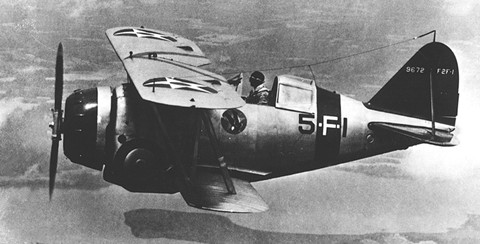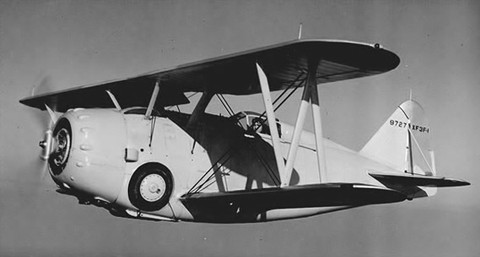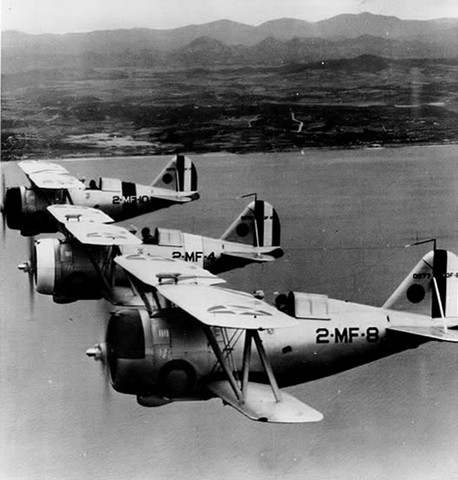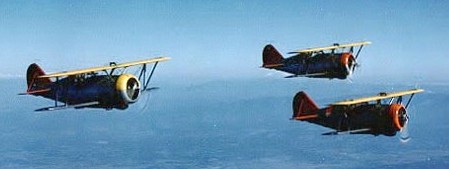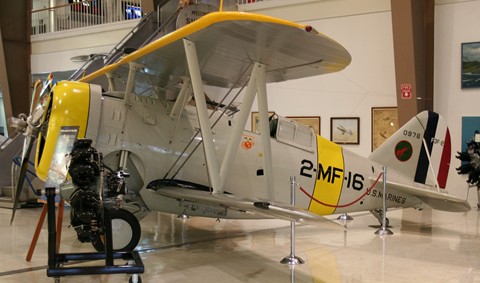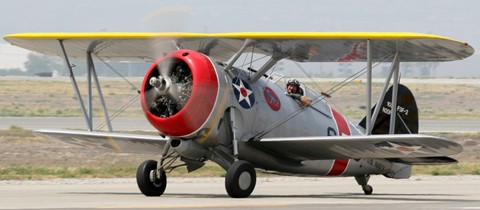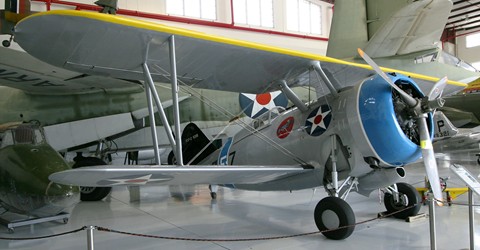|
Grumman F3F
The F3F is nicknamed 'The Barrel'. It was the last Naval biplane fighter, and was retired at the end of 1941 so it never saw combat. DevelopmentThe Navy's experience with the single-seat F2F (pictured above) revealed stability issues and unfavorable spin characteristics, prompting the October 15, 1934 contract for an improved version designated XF3F-1. This order was placed before F2F deliveries began. The contract also required a capability for ground attack, in addition to the design's fighter role. Powered by the same Pratt & Whitney R-1535-72 Twin Wasp Junior engine as the F2F, the fuselage was lengthened and wing area increased over the earlier design. Wheel diameter reduction allowed greater fuselage streamlining, eliminating the prominent bulge behind the cowling of the F2F. The first XF3F prototype (Bu# 9727) was flown on March 20, 1935 with Grumman test pilot Jimmy Collins making three flights that day. Two days later, six dive-recovery flights took place. On the tenth flight, the aircraft's pullout at 8,000 ft registered 14g on the test equipment. The aircraft broke up in midair, crashing in a cemetery and killing Collins.
A second, strengthened prototype with the same Bu# 9727 (pictured above) was built, but it crashed on May 9th of the same year following the pilot's bailout during an unsuccessful spin recovery. Following the conclusion of the flight test program, 54 fighters were ordered on August 24th of that year. ServiceThe first production F3F-1 (Bu# 0211) was delivered on January 29, 1936 to the test group at Naval Air Station Anacostia, with squadron service beginning in March to VF-5B of the USS Ranger (CV-4) and VF-6B of the USS Saratoga (CV-3). Marine squadron VF-4M received the last six (Bu# 0259-0264) in January of 1937. Grumman wanted to take advantage of the powerful new 950 hp (708 kW) Wright R-1820 Cyclone supercharged radial engine. They began work on the upgraded model without a contract. The engine's larger diameter changed the cowling's appearance, making the aircraft look even more like a barrel, though top speed increased to 255 mph (410 km/h) at 12,000 ft (3,658 m).
An order for 81 aircraft was not placed until July 25, 1936, two days before the new prototype’s first flight (XF3F-2, Bu# 0452). Photo above shows three F3F-2 aircraft from Navy squadron VMF-2. Bureau numbers from front to back are 0977, 0973, and 0979.
End of the LineWith new monoplane fighters like the Brewster F2A and Grumman's own F4F Wildcat taking longer to develop than had been planned, the Navy ordered 27 improved F3F-3s (Bu# 1444-1470) on June 21, 1938. These aircraft were based on the XJ3F-3 prototype. See photo above showing three F3F-3 aircraft from Navy squadron VF-5 off the USS Yorktown (CV-5).
When the Brewster F2A-1 was introduced, the Navy's biplane fighter days were numbered. All 'Flying Barrels' were withdrawn from squadron service by the end of 1941, though 117 were assigned to naval bases and used for training and utility duties until December 1943. A few were used by the US Army Air Force as ferry-pilot trainers, under the designation UC-103. SurvivorsWe know of five survivors, all of them are F3F-2s. Two of these rare aircraft still fly: Bu# 0972 is on static display at the Texas Aviation Hall of Fame, Galveston, TX. Bu# 1005 is on static display at Quantico Museum, VA.
Bu# 0976, pictured above, is on static display at the Museum of Naval Aviation, Pensacola, FL.
Bu# 1033 is flyable and is based at the Planes of Fame Museum, Chino, CA. As you can see it still flies.
Bu# 1028 is flyable and is based at
Fantasy of Flight,
Polk City, FL. This aircraft is still flyable but we have not seen it in the air for years.
|
